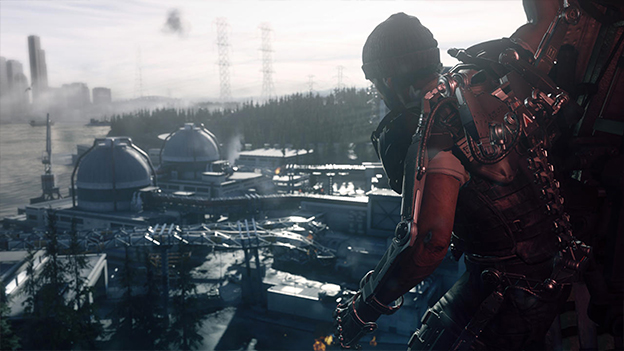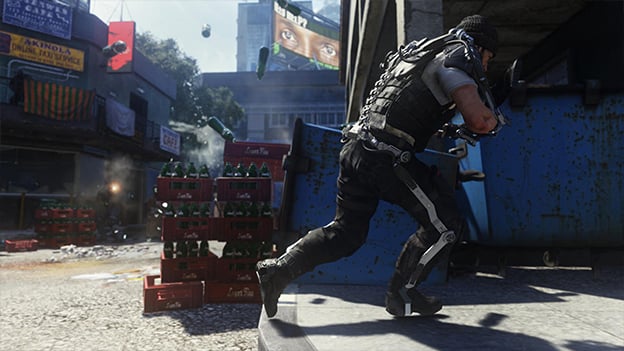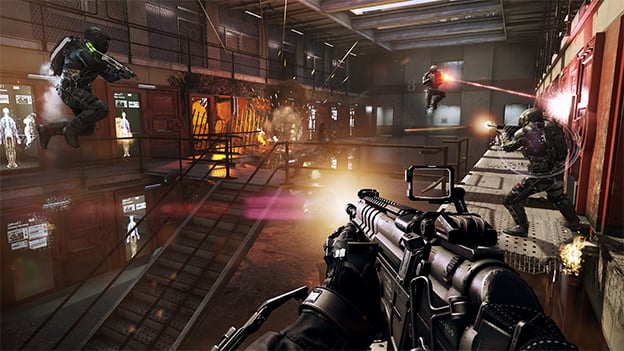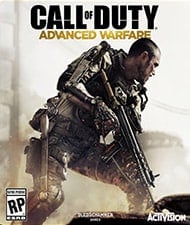Advanced Warfare, Advanced Storytelling
Call of Duty: Advanced Warfare was advertised as a brand new way to play Call of Duty , and that advertisement was right! When Activision flew me out to San Francisco to review the game, I wholly expected my opinion to fall in line with how I felt about past Call of Duty titles. The single-player would be OK but would really just be a side show to the main act of multiplayer. However, after playing the game, I have to say that my pre-conceived notions were flipped on their head. Instead, I was met with a multiplayer suite that was decently fun, but a single-player mode that was one of the best in Call of Duty ’s history.
So let’s talk about the single-player first. There are a lot of things that are different this time around, more than just the futuristic time period of the 2050s. For the first time in Call of Duty history (spoiler spoiler) the main villain is American (OK he is technically “South African” because that’s where he grew up, but he is white and certainly American seeming, and the single-player designers at Sledgehammer said that was on purpose.)
Jonathan Irons, played by Kevin Spacey, is the CEO of the world’s largest Private Military Corporation, Atlas, and he sort of stands as an icon for industrialism and capitalism. His catch phrase is, “I care about profits, not policy.” He has so much backing and has been so successful in the field that his technology far outranks the American military’s. He has more troops, he has more power, he has more ambition, and while this originally paints him as an entrepreneur and even a savior when the world’s governments cease to function, eventually this power mixed with his own conflicted personal issues and views turn him into a villain. For the first time, Call of Duty doesn’t fall into the same “random country gets uppity and threatens the American way” pattern, and it is a HUGE breath of fresh air.
The plot of the single-player goes a little something like this: you are Mitchell, a former soldier who lost his best friend, Will Irons AKA Jonathan Irons’ son, on the battlefield. You lose your arm in battle and Irons decides to invite you into his PMC, offering you the best robotic prosthetic money can buy. This arm ends up being an important symbol in the game, as Will died because his arm got caught in a helicopter door before an explosive charge went off. The arm you receive stands for the void created by the loss of your friend, and the robotic arm you receive stands for the way you try and fill that void with work for his father’s PMC.
Life in Atlas is pretty good, all things considered, until you learn that Irons is withholding information from the world’s governments which could allow them to stop terrorist attacks from an anti-technology renegade called Hades. Instead, he let the attacks happen, allowing the world to slowly become more and more reliant on Atlas, until his PMC controlled every major port, supply line, airline, and more. It’s then that he develops a biological weapon that kills based on a DNA signature. With a push of a button he can destroy anyone who isn’t a part of Atlas, or one of Atlas’s allies. He decides to end world war by becoming the one and only true military force in the world, and it’s around this time that you realize, “Maaaaybe I shouldn’t be fighting for this guy anymore” and embark on a mission with fellow deserters to knock Irons off his throne.
I cannot emphasize enough how great this story is. It was incredibly gutsy for Sledgehammer Games to make the main villain of a Call of Duty title this American CEO upward mobility stereotype. It was heavily alluded that Will and his father didn’t get along before his death, and so without Will to fight with, Irons starts blaming everyone and everything for his son’s death. He blames America. He blames world governments in general. He blames the very concept of war, until he eventually comes to the realization that only his supreme force can bring world peace.

Yet as crazy as Irons is, as absolutely sociopathic he has become, there is this nagging voice in your head that says, “Irons has a point.” He constantly monologues about how ineffective the world’s governments are at preventing war, and how, only by inviting in his corporation, have the world’s conflicts been solved. He brings to light all the bad things about war profiteering, and asks you, “Would you rather be owned by a politician who lies about having your best interests in mind, or a corporation who upfront says they only want to profit off you?” Do you value truth and peace or happiness and ease of mind? His character alone is worth playing this game for and Kevin Spacey delivers a blockbuster performance unlike anything we have seen in the gaming world so far.
This story is backed up by rock solid gameplay. You’ll once again be brought to several different world locations and be asked to take on a number of different missions, but all of these missions feel unique. You are constantly playing with new toys, including threat grenades that highlight where the enemy is, smart scopes, stim abilities that heal you, overclock abilities that slow down time, smart grenades that home in on the enemy, EMPs, and more, and these are just the conventional weapons. The set piece weapons–like drones, tanks, turrets, an airplane that you fly flight sim style through a canyon, spy drones, mute charges, magnetic gloves, grapple launchers, hover packs, jet packs, and more–are even more fun to use.

If there was one problem with the single-player, it’s that the game falls back too often on the convention of, “Kill all these enemies before moving forward.” In the middle, the game drags a bit because of these shooting gallery segments, but the plot keeps you moving forward. The campaign is pretty hard, but luckily there are checkpoints everywhere. Every few steps the game saves again, allowing you to redo small portions of the game and inch your way forward. A couple times the game did error though and sent me back more checkpoints than it was supposed to, but this was rare.
What’s interesting, is that maps seem to be set up to allow you to set your own challenges, which is very new for Call of Duty single player. For example, one portion has you setting explosive charges around the map. You soon realize you can speed run this section using well timed jumps, or slowly mow your way through waves of enemies. It’s your choice. There’s a point where you have to have a firefight in the middle of traffic. You can pursue your enemies through the traffic, or bunny hop on top of vehicles. Once again, your choice. There’s just an element of replayability that you didn’t find in other Call of Duty games.
It’s also worth noting that the graphics, especially in the single-player mode, are phenomenal. The pre-rendered cutscenes look like some sort of big blockbuster CGI movie, like Avatar . Heck, sometimes I forgot I was looking at CGI. The locales feel alive, and they feel a lot less like set pieces and a lot more like environments. You feel like you have a reason to go to each new location, a reason besides, “The developers wanted to show you some explosions here.”
So like I said, the single-player mode this time around was one of the best I have seen from any Call of Duty , telling a fantastic story that criticizes capitalism, war profiteering, American war politics, and more. The multi-player, on the other hand, has a couple good ideas and is fun in its own right but falls a bit short of the single-player’s greatness.
High points of the multiplayer include the new boost jump, which allows you to quick dash on the ground, double jump in midair, air-dash (yes you heard me) and more. This allows confrontations to be a lot more mobile, which makes them a bit more interesting. Getting the drop on an enemy does not necessarily guarantee a kill, especially when you consider perks that increase your health, temporary abilities that increase your health, armor, and other ways to defend yourself. Heck, as soon as you get shot, you can start double jumping just to try to avoid death.
As a consequence, maps have also become a lot more vertical than previous Call of Duty maps, as a well-timed double jump can get you up to the roof of basically any building. Overall the game feels faster, more like an arcade shooter, like Quake or early Halo , and it’s a good feeling.
New “threat grenades” are also a neat little mechanic, as they paint targets and allow you to see them behind walls. Joining them are new EMP grenades which can shut down electronics and scorestreaks, laser guns (yes you heard me) that essentially have infinite ammo but require a long charge up time and a concentrated held blast to kill, and a TON of different loadout customization options.
In fact, loadout customization feels like some of the most deep that Call of Duty has ever gotten. You have primary weapons, secondary weapons, perks of three different kinds, “wild cards” which are kind of like perks except instead of effecting how you play in game they effect what sort of things you can equip to your loadout, “exo abilities” which are short limited use abilities like health up, speed up, etc., grenade slots, tons of weapon attachments, scorestreaks, scorestreack customizations which allow you to increase scorestreak point totals to give them abilities like increased time, increased damage, or even the ability to retain the points you earned toward them through death, and an overall point tlta that your loadout has to fall under, and this is just the mechanical stuff. Outside of mechanical stuff you can customize your appearance in a ton of ways (male or female by the way) customize your weapon’s appearance, your emblems, your tags, and much much more. If you like setting up your character before battle, you will have a field day with Call of Duty: Advanced Warfare .

But the biggest downside to multiplayer for me is the level system. Gone are COD points of any sort. Instead, each weapon, attachment, perk, wildcard, and more is locked either to your character level, or to some sort of achievement like in Modern Warfare 2 . All of the cool and interesting attachments, including many that are included in your basic pre-set loadouts, are only available after a TON of grinding. Basically, you aren’t allowed to play the game the way you like until you hit level 30ish… at least, and even then a lot of the stuff you see people using (like the sight that paints your targets) is still locked behind an achievement door. This makes jumping into the multiplayer at a low level feel incredibly demoralizing, as everyone around you is handing you your ass with these neat customized futuristic weapons, and you are still stuck using basic SMGs.
After the brilliant point system in Ghosts (despite the rest of that game’s flaws) that let you unlock whatever you want, whenever you wanted to, this feels like a giant step backwards that simply makes the level grind way less fun. Even worse, you have to unlock every single attachment for every gun you have individually. So if you get a new gun, it’s by default going to be worse than your old gun, because you can’t customize it! I feel like a lot of the content is simply walled off from me until I have ascended to the rank of the glorious pro, not considering whether I might simply not WANT to grind for hours just to get the gun I care about. Leveling up only to get, say, a sniper rifle that you will never use ever is also not a lot of fun. I know that this is basically how classic Call of Duty titles like Modern Warfare 2 handled things, but that doesn’t make it good.
There are a few systems put in place to help ease the grind a little. First there is “combat readiness training” a game mode which allows you to simply head into battle against other players and bots and try things out. In combat readiness training, you are given random loadouts based around simple themes, so here you can try tons of different guns and options that you would otherwise have to grind for. This is an awesome addition that really helps ease the transition into the game for new players.
Another thing that helps is the “care package” system. As you play through single-player and multiplayer, you will receive care-packages which include special in-game perks (like increase scorestreak speed), special weapons (like gun models with a few of their stats tweaked), cosmetic items and more. Different weapons come in different rarities, and these rare weapons can really make the difference. For example, you might hate a certain assault rifle because of its lack of accuracy, but find a rare version of it that increases accuracy for, say, fire rate or damage, and you might love it. If you don’t love it, you can always trade in these random care package items for XP as well.
Unfortunately, these care package items have their own flaws. First of all, the “rarity” system means that some people will simply get better guns than others, which I don’t like one bit. I don’t like my opponent having a rarer, basically better version of the same SMG that I am using even though he is at the same level, just because he lucked out on a random draw. I also don’t like that these drops are level locked. So if you draw a rare weapon that needs you to be level 30 in order to use it, and you are level 9, it’s just dead weight until then, tantalizing you and, once again, asking you to grind for hours. If this was really meant to help offset the grind, why not let the weapons you find in drops break the leveling system, to give everyone a small taste of what’s to come at higher levels?
Co-op modes in Call of Duty: Advanced Warfare also have their flaws. You can only really play in a classic horde style defense mode, and there’s no big theme this time around, like zombies, robots, aliens, or the like. The game mixes things up by restricting your weapons or fooling around with your enemy types, but it feels very straight forward and kind of uninspired, especially when compared to the co-op modes of the past.
And that’s what leads me to my very… very odd position right now. I want to play the multiplayer again but I really want an “unlock everything” code. There are a lot of good ideas here, from new and interesting weapons to cool exo abilities, but I just can’t stand the grind to get them.
On the flip side, the single-player is just so good. The level design is intricate. The story is amazing. The characters are believable. The theme and tone will make you think and consider war in ways you hadn’t before. The stages have hidden areas and pickups and replay value like you’ve never seen before, and even then you keep coming back as you try to speed run the game, no bullet run the game, melee only run the game, and more. Heck, this single-player has everything you could possibly want… except for a dog. A robot dog. Get on that for Advanced Warfare 2 , Sledgehammer. I want to see robo-Riley.
So that’s my final opinion on Call of Duty: Advanced Warfare . The single-player is phenomenal, and the multiplayer is good but limited by its own unlock system. I personally think the story alone is worth a purchase, and I hope that this becomes the mark of Sledgehammer Call of Duty titles in the future. Personally, I have played enough Call of Duty multiplayer already, heck, I have played enough first person shooter multiplayer in general, to know what I am getting in a multiplayer suite like this. Robot suits and double jumps and future weapons are all decently cool additions to the multiplayer formula, but a studio that is willing to criticize the U.S. government, capitalism, and global war culture in its story is a true rarity worthy of praise.
RATING OUT OF 5 RATING DESCRIPTION 4.5 Graphics
I honestly have to say the cutscenes in the single-player mode were amazing. The motion capture studio did an amazing job. 4.0 Control
The controls are about what you would expect and they still work well. I had surprising control over my boosts and boost jumps, though I still prefer a keyboard and mouse to a controller. 4.0 Music / Sound FX / Voice Acting
The music was mostly forgettable, but the actors give outstanding voice performances. 4.5 Play Value
Play the single player over and over, and check out multiplayer too! 4.4 Overall Rating – Great
Not an average. See Rating legend below for a final score breakdown.
| Review Rating Legend | |||
|---|---|---|---|
| 0.1 – 1.9 = Avoid | 2.5 – 2.9 = Average | 3.5 – 3.9 = Good | 4.5 – 4.9 = Must Buy |
| 2.0 – 2.4 = Poor | 3.0 – 3.4 = Fair | 4.0 – 4.4 = Great | 5.0 = The Best |
Game Features:
